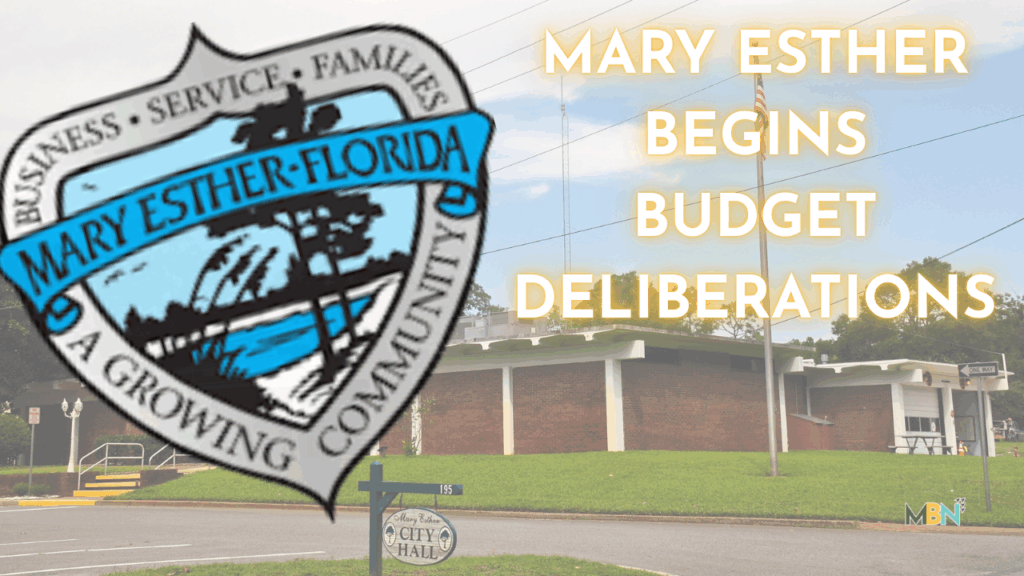
💸 City leaders are reevaluating public safety contracts amid a projected FY2026 budget deficit and rising insurance and utility costs.
🚓 Council members questioned the value of the $300,000 law enforcement contract, which funds daytime-only deputy coverage.
🏗️ Major projects like Azalea Park improvements and a utilities expansion will significantly draw down reserves and discretionary funds.
MARY ESTHER — Mary Esther city leaders are considering a top-to-bottom review of the city’s law enforcement and fire service contracts after unveiling a draft fiscal year 2026 budget that includes a deficit and new capital projects.
On July 21, the council expressed near-unanimous support for directing City Manager Jared Cobb to develop a formal scope of work for evaluating public safety service models — including the city’s longstanding contract with the Okaloosa County Sheriff’s Office.
“This is the first budget in quite a while that we actually have a deficit that we’re dealing with,” said Councilman Larry Carter. “Even though we can absorb the deficit and life would kind of be much the same… I think it’s time that we look at how we do fire and how we do public safety this year.”
The deficit stems in part from a stagnation in property values, which saw only a 2% increase this year — the lowest in at least five years; Cobb told the council. The city is also projecting a 15% hike in property and liability insurance and plans a 5% increase in water and sewer rates to keep up with inflation.
Despite the shortfall, Cobb said the city maintains healthy reserves, including a $2.14 million emergency reserve — 20% of general fund expenditures — and a projected $4.96 million unassigned balance in the utilities fund. However, the discretionary sales tax fund would be entirely spent on capital projects.
Among the most significant projects is the $3 million Azalea Park infrastructure improvement, which could be adjusted to ease financial pressure.
“If you deferred those sidewalks, that would save about another $712,000,” Cobb said, noting the council has the option to bid the sidewalks as an alternate and decide later whether to move forward.
Council members also discussed the possibility of adding funding for cemetery design work, which is currently not included in the budget.
“It’d be good to know where we sit at with what the cost would be for the cemetery, especially since we all agreed on the concept design,” said Councilwoman Susan Coxwell.
Much of the meeting centered on the city’s $300,000 annual contract with the Okaloosa County Sheriff’s Office. Several council members questioned the value of the “enhanced services” the contract is supposed to provide — namely, two dedicated deputies during daytime hours only.
“We’re paying for services that are mainly for during the daytime hours… and right now, from 8 a.m. to 8 p.m.,” Carter said. “At night, the county is basically taking care of us.”
Carter, along with other council members, noted that the additional revenue from speed enforcement camera measures along U.S. 98 may enable the city to afford expanded law enforcement coverage. Cobb confirmed studies had found more than 700 speed violations per day in the school zone areas.
Councilwoman April Sutton voiced support for restructuring the city’s fire service model by potentially joining the Ocean City fire district.
“The millage rate that we pay for the fire district would be separate, and then we could reduce the millage rate in the city to compensate. So it would basically be a wash,” Sutton said.
Mayor Chris Stein emphasized that the goal is to define what the city expects from any public safety contracts.
“What we want in the contract — not what the contract tells us we get,” Stein said.
Councilman Bernie Oder offered historical context, noting that previous data suggested daytime crime rates were higher.
“Doesn’t mean we shouldn’t reevaluate it, because we should,” Oder said. “Times have changed. Also, prices have changed.”
Cobb said staff would develop a scope of work based on council feedback and return with a draft for approval.
“The only thing I’m suggesting is that we have a very clear scope that you want this report to cover,” Cobb said. “So that staff can come back to you with a scope that you’re comfortable with.”
The proposed 2026 budget also includes over $5.6 million in general fund capital projects and $2.6 million in engineering funds for a major utilities project connecting to the Okaloosa County wastewater plant. The water and sewer components of the Azalea project alone total more than $4.3 million.
Public hearings on the budget are scheduled for Sept. 3 and Sept. 23 at 6 p.m. The council signaled a desire to finalize the scope of the public safety study well before the fiscal year begins Oct. 1.
“We owe it to ourselves and to our citizens to look at those two contracts,” Carter said. “Now’s the time to do it, without the pressure of a deadline.”
Register or login with Mid Bay News and never get another pop up on our site!